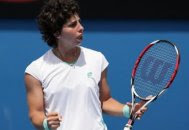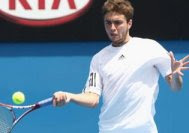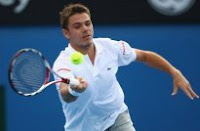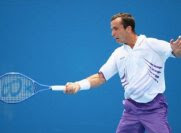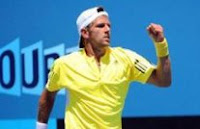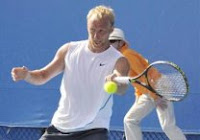(This Australian Open blog was posted on Tennis Week here.)
In my first visit to the Australian Open, I noticed that I found the experience to be more overwhelming rather than any feeling of excitement. After all, a Grand Slam is like a festival of tennis, over twenty courts of simultaneous action played at the highest level of intensity, and basically the pinnacle of tennis. But instead I felt a lack of patience, like if a match wasn’t up to standards then I wanted to be somewhere else and I found myself often uncertain about which match I wanted to watch.

I arrived about 20 minutes late and quickly made my way over to Court 3 to watch
Tomas Berdych play against
Robby Ginepri. This match I picked more due to the potential difficulty of the match-up compared to a typical early round match rather than any interest I had in either player. I was particularly disgruntled when as soon as I sat down to watch, Ginepri lost his serve at 2-1 with three or four awful errors then to later witness Ginepri continue to play at that similar standard for a further one and a half sets. Which brings to the question, is it better to simply watch players you like or the most interesting matches?
The match in itself was characterised by Berdych comfortably moving around the ball keeping the rallies going, while peppering the Ginepri forehand more often than not. Ginepri in the first set and a half barely managed to win any rallies that went over four shots or so, especially not any consecutive points in that vein. Normally I find Ginepri’s game to be strangely interesting due to his somewhat unconventional technique, but I failed to see any of that today. He would take a short loopy swing, without really having the normal forehand backswing that most other players do and if he doesn’t time it correctly it just lands all over the place.
Berdych himself looked to be playing in a relatively comfortable rhythm without much trouble until when he went a double break up in the second set, where he surrendered one of them back, and since then continued to struggle to hold onto serve, nearly almost letting Ginepri get back onto level terms. To be fair, it wasn’t only Berdych’s inconsistency. Ginepri was no longer spraying balls anymore and I didn’t need to be so pessimistic about his chances during rallies.
The atmosphere in this match was particularly strange. I think watching the matches at home, what you notice are the certain groups of supporters that are there, and in this case, Berdych had his. But sitting in a different section of the stadium, I noticed that it was more of an unbalanced atmosphere, like the cheering was really only coming from one direction, however loud it was.
So this improving performance from Ginepri put me somewhat of a dilemma after initially deciding that two sets would be enough for me. But as it happened, I took off anyway to go watch
Robin Soderling take on
Robert Kendrick.

It felt like the stands were literally packed with Swedish fans and as the day unfolded, they proved themselves to definitely be the loudest group at the Open. In particular I liked the alternating chant they were doing, by having one group on the left chanting one line, and the other group on the other side doing the next, giving the impression of the fans being everywhere. Although that’s not to say that there were few of them, because there were plenty, and later on you could hear them from all the other outside courts when Sofia Arvidsson took to the court.
This in turn, immediately made this a more entertaining match, but the tennis was of a relatively good standard as well. A match between two aggressive players, but two different types of aggressive players. Soderling likes to dominate from the back of the court while Kendrick likes to throw in some more variety and changes of pace and charge the net when he has the opportunity. I like Kendrick’s style of play, but often he found himself being pushed around not being able to regularly control the points the way he would like, and he was generally less consistent than Soderling.
I think the biggest difference between the two, was the effectiveness of the second serve. Kendrick seemed to be far more affected negatively whenever he needed to resort to one, which either could have been due to his less effective groundstrokes (not being able to serve-and-volley like he would on a first serve) or worse serving in general. So it didn’t surprise me when Soderling eventually managed to break Kendrick’s serve in each set.
I also think that Soderling has the slightly better defensive capabilities, whereas Kendrick doesn’t seem to be able to do much with the ball on the stretch. Soderling is far from being a smooth mover, but he does a good job of lunging to the ball, mainly to keep the ball going, and deep if possible rather than anything else.
From my point of view, there seemed to be a lot of line calls of shots that looked in to me, that were called out on that close sideline, but considering the view that I had, I’d assume that it was more likely me that was incorrect rather than the linesmen. At 30-30 in the game where Kendrick got crucially broken in the final set, Kendrick thought he served an ace. This is the incident that prompted Pam Shriver to come onto the court when the match finished to interview Kendrick, which amused me given that players themselves surely do not want to be doing an interview at such a heated moment.
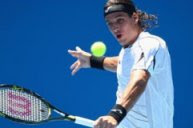
This is where I went to take a quick look at the match between
Feliciano Lopez and
Gilles Muller, the match that I found out later turned out to be an epic five-set match that extended to 16-14 in the fifth set, won by Muller. Not that I regretted walking away from it one bit. It was early in the third set when I started watching, where Lopez had just broken Muller’s serve with a couple of low slice backhands.
It’s interesting that both Lopez and Muller are considered to have relatively unique games being lefty serve-and-volleyers but playing against each other, it was a bit like watching a mirror image. Except Lopez has a one-handed backhand and Muller has a two-handed backhand but both resort to the slice more often than not so it’s barely noticeable. At first I thought watching slice backhands made a nice change, but about ten minutes later I realized I was mainly watching a match dominated by serve. It was very much a case of putting in the first strike, and not much shotmaking here to admire.
So at this point, I thought maybe I should take a look at
Taylor Dent who was returning to action after injury problems for the last couple of years or so, up against
Amer Delic. Then as I walked over to court 10, I noticed that there were really only one or two rows of seats on each side of the court to the point where if you sat down, you’d have to put up with seeing a fence. I don’t understand the scheduling decision to put a man who was once considered to be half-Australian, and had moderate amounts of success on one of the smallest capacity courts, considering that the majority of outside courts at least have around four rows of seats on each side. I later saw when the match was into a fifth set that it was packed with people standing everywhere wherever they could, with which I simply do not see how people can actually even see, then again I am relatively short.
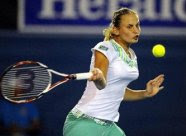
I wasn’t that desperate to watch it, I decided and the heat was hard to deal with at times so I thought I’d go watch
Jelena Dokic, another player on the comeback trail, up against
Tamira Paszek. It was much like watching the opposite of the Lopez vs Muller match. Reasonably long rallies, played under a nice rhythm. I found it amusing that even Paszek and Dokic’s grunting which is characterised by a louder level of breathing than most people, seemed to be incredibly similar.
Having seen Dokic’s match against Mauresmo in Brisbane earlier this year, the one thing that I had feared the most was her ability to take advantage of leads she had built for herself, and her serve potentially failing her. After going up an initial early break at 2-0, Dokic quickly gifted it back with two double faults. But surprisingly, that was just about the end of it, and despite brief moments of shakiness, she managed to deal with the occasion relatively well, at least compared to that dreaded Mauresmo match.
In the first set, both players were playing relatively similar styles keeping the ball going crosscourt the majority of times, and only pulling the trigger down-the-line when they had an opening. The difference was that Dokic was the more aggressive player hitting the ball harder and at a lower trajectory which in the end got her a much bigger winners tally than Paszek did.
The first set was Dokic’s most consistent set, good ball-striking and a low amount of wild errors. The one thing I noticed about both players was that whenever they were pushed on the defensive, they were rarely able to turn defense into offense, meaning that both Dokic and Paszek were not very impressive defensively. It felt like to me from watching it that the majority of shots both players were hitting seemed to be well within their reach.
The second and third sets were a more inconsistent affair with numerous changes of momentum. Both Dokic and Paszek started to go for riskier shots, down-the-line shots except Dokic’s shots were far pacier. It no longer looked like Dokic was playing a relatively patient game, sometimes trying to do too much. In the end, it seemed like the one service break in the third set for Dokic was enough to put the momentum in her favour to snatch her a second service break. Dokic showed a brief sign of nerves after going up that lead but was able to remain composed enough to serve out the match successfully.

Then I headed back over to the outside courts to catch the first set between
Paul-Henri Mathieu and
Jarkko Nieminen. I noticed that recently Mathieu has been subjected to a couple of very one-sided losses early in the season to Verdasco and Djokovic, the former of which I watched live myself in Brisbane. So I was hoping that this time Mathieu would put in a better performance this time and showcase more of his skills. Immediately right off the bat he went down a couple of break points, but saved them all with good serving, then the match started to turn right in his favour. His groundstrokes were much better this time, opening up the court nicely with accurate groundstrokes and excellent angles.
The first set was one of the more entertaining sets that I watched that day, in terms of the quality of play from both players. Nieminen in the end got pushed back most of the time, forced to play from a defensive position due to Mathieu’s controlled aggression. I didn’t notice Nieminen to be struggling noticeably with his movement until when he took an injury time-out at 5-2 in the first set, then strangely served-and-volleyed on one of his weak second serves. Then later in the game, he served a meek double fault to lose the set 6-2. I noticed him take another injury time-out after that and that was when I left the match.
I then had a brief look at the closing stages of Dinara Safina’s match which seemed to feature many breaks of serve, until Safina won the match 7-5 in the second set.

So up next on court was
David Nalbandian against
Marc Gicquel, the first full men’s match that I watched that day. Nalbandian started off the match moving the ball around well, but struggling on his serve to the point where it looked like maybe he would prefer returning instead of serving. It was interesting to specifically pay attention to the consistent accuracy of Nalbandian’s groundstrokes which seemed more impressive compared to most players. In the early stages, he was able to stave off all of his break points which made for a not very representative first set scoreline of 6-1.
Gicquel himself has relatively flat groundstrokes and short backswings on both sides. But these short backswings seemed to be nullified by Gicquel’s relatively late preparation on both sides which limited his offensive capabilities to some extent. There seemed to be a noticeable difference between Gicquel hitting a rally shot and stepping it up to change the pace whereas with Nalbandian, it all seemed relatively similar in terms of energy. In the first set, Gicquel seemed to be rushed a number of times, but he started to maintain far more consistency in the second set.
The second set is when the match started to turn with most of the focus being on Nalbandian berating himself constantly, unhappy with the feel that he was getting on the ball and his poor first serve percentage. Watching it live, it was slightly uncomfortable to watch seeing Nalbandian frequently frustrated with his own play. There were some awful forehand errors, some short balls that were dumped and his volleys were particularly poor that day sitting up high most of the time for Gicquel to put away.
Gicquel started to hang in the rallies in the second set much better, and from here on in, the rallies going on seemed to be relatively neutral whereas earlier it looked like Nalbandian had the upper hand in controlling points even though he had hit fewer winners than Gicquel that set. Having shown signs of frustration for a fair amount of time, after a while, Nalbandian imploded smashing his racquet which drew several jeers from the crowd. But that wasn’t enough to release the tension, and did so again the following point although to a lesser extent.
That was when he went through a two game period of showing some very uninspired play before composing himself again to be able to play some more solid tennis in the final two sets. I didn’t really notice much of a difference between the third and fourth sets in terms of Nalbandian’s quality of play, with the difference being that Gicquel was simply more consistent in the fourth set compared to the third.
 Each year, the Australian Open has been known to throw up some surprise packets. Players that managed to navigate their way deep into the tournament against all odds. This year's surprise packet, Fernando Verdasco has just beaten last year's surprise packet Jo-Wilfried Tsonga and two days ago, he defeated the Scot Andy Murray, the man who was initially the bookies' favourite heading into the event. Murray had shown sensational form in winning Doha, and performing well in the exhibition prior to that.
Each year, the Australian Open has been known to throw up some surprise packets. Players that managed to navigate their way deep into the tournament against all odds. This year's surprise packet, Fernando Verdasco has just beaten last year's surprise packet Jo-Wilfried Tsonga and two days ago, he defeated the Scot Andy Murray, the man who was initially the bookies' favourite heading into the event. Murray had shown sensational form in winning Doha, and performing well in the exhibition prior to that.
